July 4, 2008
Air Date: July 4, 2008
FULL SHOW
SEGMENTS
Gas Pains
/ Jeff YongView the page for this story
New public opinion polls show concern about high gas prices pushing people to favor more energy production. Living on Earth's Jeff Young looks at the energy remedies politicians are putting forward. (06:15)
Tropical Sinks Gobble Greenhouse Gases
View the page for this story
Sea spray could be doing more than just keeping beachgoers cool this summer. A team of scientists recently discovered that sinks in the tropical Atlantic are eating up greenhouse gases such as ozone at a faster rate than previously predicted. Host Bruce Gellerman speaks with Professor Alastair Lewis of the National Center for Atmospheric Science about this mystery of the missing ozone. (05:20)
Have a Heart
/ Bruce GellermanView the page for this story
For 60 years, the residents of Framingham, Massachusetts have been poked and prodded, examined and investigated to help reveal the mysteries of heart disease, the nation's number one cause of death. Host Bruce Gellerman visited Framingham to speak with some of the participants of one of the largest and most important epidemiological studies in history. (09:50)
South Africa Shark Spotters
/ Terry FitzPatrickView the page for this story
Great white sharks are found throughout the world, prompting many beach communities to set up special nets to protect swimmers and surfers. But Cape Town, South Africa is taking a different approach. They’ve set up a system of shark spotters who are on the lookout and sound an alarm when danger lurks in the water. Producer Terry FitzPatrick explains how it works. (05:45)
Emerging Science Note/Lava Land
/ Alexandra GuitierezView the page for this story
Yellowstone’s on the rise and molten lava’s on the move. Alexandra Gutierrez reports. (01:30)
On the Road
/ Verlyn KlinkenborgView the page for this story
When commentator Verlyn Klinkenborg traveled from California back home to his farm in rural New York, along the way he found himself asking “Could I live here?” (03:00)
Manure Magic
/ Ashley AhearnView the page for this story
Dealing with large amounts of manure on industrial livestock farms has never been easy, environmentally sustainable, or profitable, but that's starting to change. Living on Earth's Ashley Ahearn reports on a growing industry that capitalizes on the power of cow and pig poop. (06:45)
Winged Rats or Wronged Warriors?
View the page for this story
Living on Earth drops in on pigeons, for a change. Author Andrew Blechman joins host Bruce Gellerman to discuss why this once-lauded war hero has been pigeon-holed as a public enemy. (06:50)
This week's EarthEar selection
listen /
download
Sounds from the northern prairie.
Show Credits and Funders
Show Transcript
Host: Bruce Gellerman
Guests: Alastair Lewis, Andrew Blechman
Reporters: Jeff Young, Ashley Ahearn, Verlyn Klinkenborg, Alexandra Gutierrez, Terry Fitzpatrick
[THEME]
GELLERMAN: From Public Radio International - this is Living on Earth. As we dig deeper into our pockets to pay for gasoline..a new poll finds Americans are more willing to dig close to home to find new sources of energy.
DOHERTY: Many more people now prioritize greater energy exploration - mining, drilling, construction of new power plants - over conservation and regulation. And that’s a pretty significant shift.
GELLERMAN: Coming up; how shifting public opinion is driving congress and energy legislation this summer. Also: 60 years and three generations later a landmark study reveals ways you can reduce your risk of heart disease:
LEVY: I like to tell people even if you chose your parents unwisely there’s still a lot you can do to modify your destiny. In other words it’s in our hands.
GELLERMAN: And home is where the heart is – our commentator shows the way - These stories, this week on Living on Earth. Stick around!
[NPR NEWSCAST: Boards Of Canada “Zoetrope” from “In A Beautiful Place Out In The Country” (Warp Records 2000)]
Gas Pains

Republican Senator Lamar Alexander answers questions after unveiling a proposal to lower gas prices by “finding more and using less"--the Gas Price Reduction Act of 2008. (Courtesy of Lamar Alexander)
GELLERMAN: From the Jennifer and Ted Stanley Studios in Somerville, Massachusetts - this is Living on Earth. I’m Bruce Gellerman, in for Steve Curwood. The price of petroleum products is swaying public opinion polls and that has politicians paying close attention as the campaign season hits high gear. And Living on Earth’s Jeff Young reports, the parties have very different positions on how to win votes and influence energy prices.
YOUNG: Just north of the capitol building there’s a little patch of lawn used for outdoor press conferences—Capitol Hill regulars call it “the Swamp.” On a bright day in late June the Swamp looked like a car lot of the future.
[HOOD OPENING]
FEMALE VOICE: Look at that!
TECHNICIAN: SO this is a power electronics unit. Used to be a motor. No grease, no oil.
YOUNG: Half a dozen electric drive vehicles were on display. Nevada Senator Harry Reid, the Democratic leader, had a look at one that can do a hundred miles an hour.
REID: Fasten your seat belt on that one.
[LAUGHTER]
YOUNG: Reid says Democratic proposals would support electric cars and other clean energy alternatives with tax incentives but Republicans are blocking them.
REID: We want to do something about global warming. That’s why we want to do something about gas prices and we want to do something with alternative energy and sadly we’ve been stopped every step of the way by Republicans who say they want to do more fossil fuels, put more carbon into the air. We cannot.
YOUNG: Democrats favor taxing windfall profits of oil companies unless those companies invest more in energy production and alternative energy research. And Democrats used high profile hearings to focus on speculation in oil markets. North Dakota Senator Byron Dorgan says market watchdogs have been taking a nap.
DORGAN: This is an orgy of speculation in the commodities futures market we are trying with this legislation on floor of senate to wring the speculation out of markets and bring price back down where it ought to be relative to supply and demand.
YOUNG: One week later the Swamp was the scene of another energy press event. This time dozens of Republican Senators crowded around the podium to unveil their energy proposal. Tennessee’s Lamar Alexander says Republicans also like electric cars and dislike oil market speculators. But their main point is a need for more US oil.
ALEXANDER: Our bill can be summed up in four words: find more use less.

Republican Senator Lamar Alexander answers questions after unveiling a proposal to lower gas prices by “finding more and using less"--the Gas Price Reduction Act of 2008. (Courtesy of Lamar Alexander)
ALEXANDER: When we say deepsea exploration they say no we can’t. When we say oil shale development they say no we can’t.
YOUNG: And as for the greenhouse gases that would come from burning that additional oil, well, that’s not a high priority for New Mexico’s Pete Domenici, the top Republican on the Senate energy committee.
DOMENICI: The USA faces economic destruction because of our dependence on foreign oil long before we will ever feel the effects of greenhouse gases. There’s no way to avoid it we must use crude oil and that crude oil use must be more ours than foreigners’ or we will die an economic death.”
YOUNG: Democrats counter that oil companies are not drilling on some 58 million acres of land and water where they already have access. They propose a “use it or lose it” rule that would revoke idle leases. Republicans say Democrats don’t understand how the market works, and Senator Alexander took a shot at Democratic presidential candidate Barack Obama.
ALEXANDER: Unfortunately most Democrats still insist on trying to repeal the laws of supply and demand. It’s a new economic theory, we might call it Obamanomics
YOUNG: Democratic leader Reid accused Republican candidate John McCain of flip flopping on offshore drilling.
REID: In one of his previous political lives he said he was opposed to offshore drilling”
YOUNG: And so it went, with partisan sniping reaching a crescendo just before Congress’s July 4th break. Back home, lawmakers will surely get an earful about energy prices. New polling data show there’s been a big change in what many voters want. For seven years the Pew Research Center for the People and the Press has asked about priorities in energy policy—do people want more exploration and development or more conservation and regulation? Pew center associate director Carroll Doherty says the majority had favored conservation. New numbers released July first —after gas prices jumped to four dollars a gallon—show that’s no longer true.
DOHERTY: Many more now prioritize energy exploration mining drilling new power plants over conservation and regulation. It’s a 12 point gain just since February and that’s a pretty significant shift.
YOUNG: Doherty’s numbers show much of that change came from unexpected
places—groups usually inclined to favor conservation.
DOHERTY: What you’re seeing is a shake up of long held public opinion on this. Liberals, women, young people—these are groups that by and large prioritized conservation over expanded exploration in the past now moving in big shift there in favor of increased energy exploration.
YOUNG: That would seem to favor the Republican approach. But Doherty says the increased support for more drilling has not come at the expense of strong support for other measures like higher mileage cars, alternative fuels and mass transit.
DOHERTY: So the public is basically saying, ‘all of the above,’ at this point to a lot of different approaches to the energy problem.
YOUNG: That hints at growing public support for a mix of the Republican emphasis on energy supply and the Democrat’s desire to reduce demand. But with election season upon us, the high ground of a bipartisan agreement is hard to reach in Washington. It’s much easier to schedule more press conferences and blame the other guys down in the swamp. For Living on Earth I’m Jeff Young in Washington.
Related links:
- New polling on energy priorities from Pew Center for the People and the Press
- Democratic Congressional leaders on their energy agenda
Tropical Sinks Gobble Greenhouse Gases
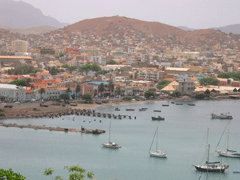
Sao Vicente (Photo: Bryan Ho)
GELLERMAN: You’ve heard of a who-done it - this is a what-done it. Last year, a team of scientists on the remote Cape Verdean island of São Vicente noticed something very strange. Large amounts of ozone, almost half as much ozone as climate models predicted should be above the tropical Atlantic Ocean, were missing. To solve the mystery of the missing greenhouse gas, scientists built new instruments loaded them onto airplanes and took to the skies. And what they detected just might help save the planet from global warming. Professor Alastair Lewis is the science sleuth who led the investigation. He’s Director of Atmospheric Composition at the National Center for Atmospheric Science in York, England. Welcome to Living on Earth Professor Lewis!
LEWIS: My pleasure. Great to talk about these things on a science show.
GELLERMAN: So where did the ozone go?
LEWIS: Okay, so ozone is destroyed when it’s hit by sunlight and the things that you need to destroy ozone efficiently is lots of sunlight and so it’s no big surprise that the tropics are gonna be the place where we’re gonna get the highest lost. What’s surprising here is that we found more loss than you would explain just by sunlight hitting the molecule on its own. And in fact what we found was some extra chemicals that speed up this process and add on top of it and this was the big surprise. And in fact these processes involve some rather unusual chemicals involving bromine and iodine.

Sao Vicente (Photo: Bryan Ho)
LEWIS: They sort of come from the same place but not the same source if you take what I mean. So you have bromine which we believe comes from small microscopic particles in the air that are generated over the oceans by waves breaking. The iodine compounds well it’s a bit more uncertain. We think they probably come from small microscopic biological entities in the ocean but again we’re a bit less certain. But they come from the ocean anyway.
GELLERMAN: So these two chemicals they interact with the ozone and somehow they turn it into something which is not a greenhouse gas?
LEWIS: That’s right they destroy the ozone and turn it into something that isn’t a greenhouse gas. And part of this process—it’s a very complicated set of reactions, it’s not a single easily described step—but one of the outcomes is actually you also begin to destroy a little bit extra of the greenhouse gas methane as well.
GELLERMAN: So these two chemicals in this particular part of the Atlantic Ocean are released. Why this particular part?
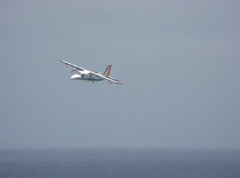
The NERC 228 Dornier research aircraft taking measurements over the ocean close to the Observatory.
LEWIS: Well this is why the discovery is quite important. We don’t think there’s actually anything specific and unique to this bit of the ocean. Our hypothesis is actually this is very typical open ocean for the tropics; there’s nothing unusual here. So if we see these chemicals released and the ozone disappearing in these places because of this it could well be happening all over the tropical Atlantic, all over the tropical Pacific as well. So we think our findings may scale up to cover large chunks of the planet.
GELLERMAN: Well this is really good news.
LEWIS: The sort of the glass half full view of course is that this is good, this means that if we get to grips with reducing our methane emissions the atmosphere will clean itself up quicker than we thought—this is good. If you take the glass half empty view, it’s well, we did a pretty good job of predicting methane so perhaps it means there are additional sources that we haven’t taken account of. But we view this generally as a positive thing. If you get to grips with reducing your emissions, the atmosphere will do its bit slightly quicker, clean us up, and give us a sort of quicker win in terms of reducing greenhouse gases.

The Atmospheric Observatory at the Cape Verde Islands. (Courtesy of Dr. Katie Read, University of York)
LEWIS: Well it certainly shows that we need to keep an open mind, that actually there are some things out there in remote places that are pretty important, that we actually haven’t discovered or accounted for yet, that it’s not a completely done deal in terms of the chemistry of the atmosphere, that there are still some discoveries to come. Understanding how the climate works is still subject to big uncertainties so there are big processes that perhaps we haven’t discovered, or processes that we don’t understand accurately and we need to go to these places to really try all of it and really nail them down and actually determine how fast they’re happening.
GELLERMAN: Boy science is deliciously complex and surprising.
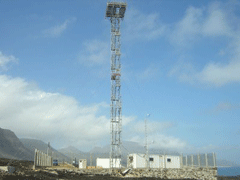
The observatory. (Courtesy of Dr. James McQuaid, National Centre for Atmospheric Science)
GELLERMAN: Why did you decide to set up your equipment and your laboratory in Sao Vicente of all places? I mean that’s way out there.
LEWIS: Well this is I’d love to say it was all science but it isn’t all driven by science this. Partly we had to wait until we could make the instruments that would do the job for us, that would actually measure year round. And part of it was finding somewhere that you could actually get to and do these experiments relatively easily. And one thing that’s happened in Cape Verde recently, certainly over the past five years, is that it’s become a very popular holiday destination. So what this opened up for us was the potential to fly there, set up instruments, move freight around, in a way that perhaps we wouldn’t have been able to do perhaps ten or fifteen years before. So it’s these sort of combination of partly science and partly serendipity that means that we’ve chosen this as our location.
GELLERMAN: Boy, not bad work if you can get it.
LEWIS: Well it’s nice to go to a place with a decent beach.
GELLERMAN: Professor Alastair Lewis is Director of Atmospheric Composition at the National Center for Atmospheric Science in York, UK.
[MUSIC: Zeph & Azeem “Time To Wake Up” from Rise Up (OM Hip Hop 2007)]
[MUSIC: Jackson Conti “Sao Paulo Nights” from Sujinho (Mochilla Records 2008)]
GELLERMAN: Coming up: Scanning hearts for disease and the seas for sharks - Those stories just ahead on Living on Earth.
[MUSIC: Jeff Coffin: “Tag” from Mutopia (Compass Records 2008)]
Have a Heart
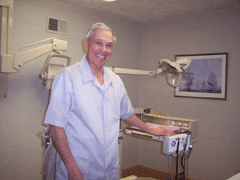
Dr. Anghinetti (Photo: Bruce Gellerman)
GELLERMAN: It’s Living on Earth, I’m Bruce Gellerman.
[MUSIC: Benny Goodman “We’ll Meet Again” from ‘Sentimental Journey: Hits from the Second World War’ (Legacy—2007)]
In 1945 more Americans died of heart disease than all the U.S. soldiers killed in action during World War II. Cardiovascular disease has been an epidemic since 1921, when it became the leading cause of death in the United States. Cardiologist Dr. Daniel Levy:
LEVY: Remarkably very little was known about its underlying causes. Even less was known about its treatment, and absolutely nothing was known about approaches to its prevention. Really, the wake-up call was when President Roosevelt died in 1945 from untreated, uncontrolled hypertension.
OLD NEWS BROADCAST: We interrupt this program to bring you a special news bulletin from CBS World News. A press association has just announced that President Roosevelt is dead. The president died of a cerebral hemorrhage. All we know so far is that the president died at Warm Springs in Georgia.
LEVY: Shortly before he died, when he was in Yalta in February of 1945 carving up the map of the free world, his blood pressure was running about 250 over 150—numbers that many physicians in training today never see.
GELLERMAN: That’s because today physicians know a lot more about the causes and prevention of cardiovascular disease, thanks in large measure to the small town of Framingham, Massachusetts, 20 miles west of Boston. Residents of Framingham had participated in a study of tuberculosis during World War I. So in 1948, when federally funded Harvard University researchers went looking for a convenient place to study heart disease, they chose Framingham. Five thousand two hundred and nine adults volunteered to undergo medical exams every other year. Now the Framingham Heart Study is commemorating its 60th anniversary. It’s one of the largest, longest-running, and most important observational medical studies in the world.
Dr. Daniel Levy is director of the study and author of the book, “A Change of Heart: How the people of Framingham, Massachusetts helped unravel the mysteries of heart disease.”
LEVY: One of the reasons Framingham was so good for this study was because it was so ordinary. There was nothing exceptional about it. It was average people, a little cross section of America, albeit of white America. But, Framingham was not an unusual town. We very much lucked out. Society has lucked out that there’s a community like this willing to be questioned, poked and prodded have blood taken from you and get nothing in financial return whatsoever.
[SOUND OF DRILLING]
GELLERMAN: Framingham dentist David Anghinetti is one of those who study researchers have poked and prodded.

Dr. Anghinetti (Photo: Bruce Gellerman)
GELLERMAN: The Framingham Heart Study was supposed to last 20 years, but in 1968 researchers decided to continue and expand the study to include the children of the original volunteers. And years later their children were also included. In all, nearly 16,000 residents of Framingham—three generations. Dentist David Anghinetti:
ANGHINETTI: Both of my parents were original participants. My mother had just some mild hypertension but she lived to 98 and a half. My father will be 102 and he doesn’t have any heart disease. When they got the additional funding to carry on the study, they then wanted to get the children involved and as soon as I got notified, I became a participant. My son has gone. My daughter has not been called but hasn’t gone yet. And I’m hoping that my daughter will take advantage of it. And, you talk to any participant, they’ll all tell you the same story: there’s a relationship that—and a bond and a trust and an admiration that the participants have for the researchers and the researchers have for the participants.
[CYCLING SOUNDS]
SULLIVAN: They like you to have you get your heart rate up to—maybe in my case—maybe a hundred.
GELLERMAN: Walter Sullivan is also a participant. He hops on the stationary bicycle he keeps parked in the bathroom of his home at a senior community in Framingham.
SULLIVAN: It’s good to get the heartbeat to be increased for some reason.
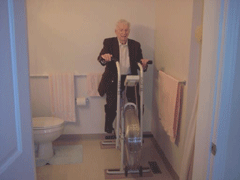
The Framingham heart study findings have spurred Walter Sullivan to keep up the healthy exercise.(Photo: Bruce Gellerman)
SULLIVAN: So if I have a salad it goes crunch, crunch, crunch. So I take the damn things out.
GELLERMAN: Walter Sullivan’s wife Katy was also an original heart study participant. She was 87 when she died in 1999, a victim of the silent killer that strikes half a million Americans a year.
SULLIVAN: She had a stroke, so she never recovered consciousness and she died the next morning. She had no history of that.
GELLERMAN: The Framingham researchers only collect data. If they find something medically wrong with a volunteer they don’t treat them, but send the test results to their personal physicians. When the study began in 1948 few people had health insurance so volunteering was one way to get regular medical exams.
SULLIVAN: This will be my 30th next year, every two years for 60 years. I look forward to it.
GELLERMAN: Your participation in this study, it seems to me may have contributed to extending the lives of countless numbers of people.
SULLIVAN: Well I’m so happy with the reaction of the people of Framingham. They were doing something with their fellow citizens that was helpful to society. So, it’s a good feeling, especially for a kid who grew up in Framingham.
GELLERMAN: Walter Sullivan’s three children and now seven of his grandchildren also participate in the heart study. Again, director Daniel Levy:
LEVY: When we recruited our third generation of participants, literally there was hardly a day that went by when one of these 3rd generation individuals did not come in and say, ‘I have waited all my life for this day to come.’ And every time I heard someone say that, it gave me goose bumps.
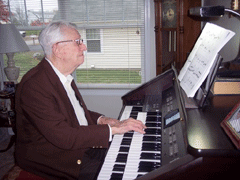
93 year-old Walter Sullivan has been a heart study participant from the beginning. (Photo: Bruce Gellerman)
The Framingham Heart Study has produced over 15 hundred articles in leading medical journals, and it’s mission has again been expanded. Researchers are now mining their data to discover the genetic basis of not just heart disease and stroke, but cancer, arthritis, diabetes and dementia. It could lead to new ways to diagnose and treat these illnesses. But Dr. Levy is cautious about over-emphasizing the genetic links to disease:
LEVY: I like to tell people; ‘Even if you chose your parents unwisely, there’s still a lot you can do to modify your destiny.’ In other words it’s in our hands. Yes, having family members with premature disease can roughly double your risk of developing a heart attack compared to someone with no family history, but much of that is mediated through things we can control. So even if you do have a bad family history by keeping your cholesterol level very low, your blood pressure low, by not smoking, by being physically active, we would eradicate about 90 or 95 percent of heart disease.
[STUDY PARTICIPANT WALTER SULLIVAN PLAYS “STARDUST” ON ORGAN]
SULLIVAN: I fiddle with it, and I have books with all of the songs that I try to get to fiddle and play every once in a while.
GELLERMAN: Ninety four-year old heart study volunteer Walter Sullivan follows the life sustaining advice, and then some. A few years ago he answered a newspaper ad placed by a local music company.
SULLIVAN: They formed a group of older people. And they offered to give them lessons for the rest of their lives if they bought an organ (laughs).
GELLERMAN: You’re getting your money’s worth, aren’t you?
SULLIVAN: But my life must have ended two or three years ago because they stopped the lessons, mostly because the participants moved away or died. So I just do it on my own now.
[“STARDUST” FINISHES]
GELLERMAN: Walter Sullivan nearly halfway through his ninth decade and the Framingham Heart Study now in its 7th. Both—still going strong.
SULLIVAN: Not very good, is it?
GELLERMAN: It’s great.
SULLIVAN: But I have fun.
Related links:
- The Framingham Heart Study
- The National Heart Lung and Blood Institute's site dedicated to the Framingham Heart Study
[MUSIC: Clifford Brown: “Stardust” from ‘Brownie: The Complete Emarcy Recordings of Clifford Brown’ (Emarcy Records—1989)]
[MUSIC: John Williams “Theme from Jaws” from ‘John Williams – Greatest Hits 1969 – 1999’ (Sony Music—1999)]
South Africa Shark Spotters
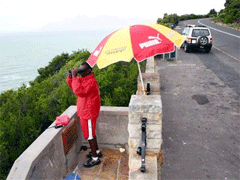
Sharkspotter (Photo: Shark Spotters)
GELLERMAN: They’re out there, lurking in the deep, hungry, waiting.
[MUSIC FROM “JAWS” THE MOVIE]
GELLERMAN: Actually, sharks aren’t all that dangerous. According to the International Shark attack file, there were just 62 confirmed , unprovoked shark attacks on people in all of 2006. In fact, in the United States, you’re three times more likely to be fatally attacked by an alligator than a shark and 37 times more likely to die from a snake bite.
Still, you don’t want to have a close encounter with a great white in the deep blue, so beaches where sharks share the water with swimmers are trying out new ways to protect people. In Cape Town, South Africa they’ve created a network of “spotters” who sound an alarm when danger lurks below.
Reporter, Terry Fitzpatrick, lived to tell the tale.
[OCEAN SOUNDS]
FITZPATRICK: If you’re swimming along Cape Town’s ocean beach, this is a sound you do not want to hear.
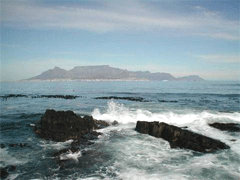
Cape Town's clean, temperate waters support seals, rays, dolphins, penguins, whales—and more than 250 great white sharks that prey on them. This is Cape Town as seen from Robben Island. (Photo: Terry FitzPatrick)
[THREE BLASTS OF HORN]
FITZPATRICK: This is just a test. But about 50 times a year this horn--and an even louder siren-- signal an actual alarm. It means a great white shark is swimming toward shore.
[THREE BLASTS OF HORN]
FITZPATRICK: Yvonne Kamp of the Cape Town shark spotter patrol says the warnings work.
KAMP: It really just takes a few minutes. That siren goes and everybody knows the drill. The shark spotters also walk up and down and blow whistle and wave hands, you know whatever it takes to get the last people out of the water.
[BEACH SOUND FADES DOWN MOUNTAIN ROAD SOUND FADES UP WITH WALKIE-TALKIE SOUND]
FITZPATRICK: The shark spotters are a team of 20 specially trained lookouts, funded by the city of Cape Town, the World Wildlife Fund and local surf shops. Their work begins not on the beach, but in the mountains high above shoreline.

(Photo: Shark Spotters)
PROVINS: Muizenberg beach watch from Muizenberg mountain watch.
FITZPATRICK: Here, Tracey Provins peers at the ocean using high-power binoculars.
PROVINS: Visibility is about ten percent. I’ve got about 20 surfers and ten bathers, copy.
FITZPATRICK: Provins says a great white shark is hard to miss. They can grow up to 20 feet long.
PROVINS: It’s a dark shadow. Most of the time, they don’t come up. If they come up, we’ll just see the fin.
FITZPATRICK: Provins uses a walkie-talkie radio to warn the beaches below. She tracks everything in the water because wherever there’s prey, predators follow.

From mountain lookouts, Shark Spotters peer at the coastline for tell-tale shadows or fins in the water below. (Photo: Shark Spotters)
FITZPATRICK: Great white sharks are a particular problem in Cape Town. At least 250 of them come to feed at a seal colony that lives on an island close to shore.
Marine biologist Alison Kock at the University of Cape Town has been using underwater radio beacons to study the sharks.
[TAPPING TRANSMITTERS]
FITZPATRICK: The beacons look like thick grey pencils with fishhooks at the end.
[TAPPING TRANSMITTERS]
KOCK: And what we have here is an acoustic monitor. And what these do is they work in conjunction with a transmitter, which we tag the sharks with. So when we get up close and personal with the sharks, we try and attach these transmitters to them. And this transmitter sends out a unique code.
FITZPATRICK: Kock’s research reveals that sharks stay away from shore when there are newborn pups to eat at the seal colony. But at this time of year, sharks rove closer to the beach in search of other prey. She says great whites are not man-eaters by nature. But they are inquisitive.
KOCK: White sharks are particularly confident, curious animals. They’re really interested in people. And for the most part they don’t do anything. They swim by, they have a look, they swim by, and they carry on swimming.
FITZPATRICK: But with more than 100 teeth, even a curious nibble from a great white can maim or kill a person. Cape Town’s shark spotter program began three years ago after a series of attacks. There were calls to cull the shark population. But great whites are an endangered species, and Kock says killing them would upset the region’s balance of marine wildlife.

Shark Spotters fly flags and sound sirens at key beaches to warn swimmers and surfers about the presence of great white sharks. (Photo: Shark Spotters)
[MARINA COMPRESSOR SOUND FADES OUT, BEACH AMBIENCE FADES UP]
FITZPATRICK: Shark spotter Yvonne Kamp says safety nets were ruled out for Cape Town because sharks, dolphins, turtles, penguins and whales get tangled in them and die. She says her network of warning stations is a healthy compromise.
KAMP: When people’s lives are threatened, everyone’s really keen on keeping the people safe and not so worried about the sharks. What we’re trying to do is find a balance, where we’re keeping people safe, but we’re also not harming the ocean.
FITZPATRICK: Many surfers and swimmers support this approach.
WOMAN: People should leave the water first before taking out any sharks. You know, it’s their world and they should be left alone.
MAN: I think the sharks have just as much right to be in the water as we have, and they are entitled to be there.
WOMAN: I think if they wanted to attack people there would be more attacks, because there are a lot out there. So basically, you take your chances. (laughs)
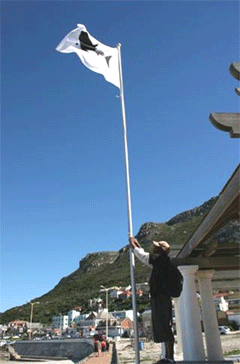
(Photo: Shark Spotters)
FITZPATRICK: The shark-spotting program does more than safeguard the beach. Yvonne Kamp says it increases awareness about the role sharks play in the marine ecosystem. And it provides jobs.
KAMP: The shark-spotting program is primarily a safety program, but it's also creating opportunities for people, like the shark spotters. A lot of them of them were unemployed. So there’s a lot of other spin-offs from the program besides the safety of the people in the water.
[WALKIE-TALKIE CHATTER “I just need a situation, please give me your situation, please.”]
FITZPATRICK: The spotting team seems to be beating the odds. According to Shark Attack File, a group that tracks incidents worldwide, roughly 90 shark bites are reported each year. On average, six people are killed. But since the spotters began protecting ten popular beaches, they haven’t had a single shark attack.
[WALKIE-TALKIE CHATTER “Okay, can I get the situation please.”]
FITZPATRICK: For Living on Earth, I’m Terry Fitzpatrick in Cape Town.
[BEACH SOUND FADES OUT]
Related links:
- Shark Spotters website
- Global Shark Attack File
[MUSIC: John Williams “Theme from Jaws” from ‘John Williams – Greatest Hits 1969 – 1999’ (Sony Music—1999)]
Emerging Science Note/Lava Land
GELLERMAN: Just ahead, we drop in on a pigeon for a change. But first, this note on emerging science from Alexandra Gutierrez.
GUTIERREZ: In America's heartland lies one of the world's largest 'super volcanoes.' Its last eruption was 1000 times more powerful than that of Mt. St. Helens, and it's capable of covering half the continent in volcanic ash. Now, this super volcano is rising up from the ground.
No, that's not the plot of a holiday blockbuster. It's the findings of University of Utah seismologists. Yellowstone National Park hosts one of the world's largest volcano fields. Its many geysers and hot springs suggest the park lies above a 'hot spot,' an area of the earth's crust that has experienced volcanic activity for an incredibly long period of time – in this case about four million years.
Now scientists say that parts of the park floor are rising at record rates. Since 2004, the floor of the park has risen approximately three inches per year. Usually, the elevation changes no more than a fraction of an inch.
Researchers believe that this movement is due to a massive injection of molten rock six miles beneath the park's surface. They used a computer simulation to reveal that a slab of magma the size of Los Angeles has been putting pressure on the area and likely causing the uplift.
But this activity shouldn't be cause for alarm. The rate of land uplift has slowed, and there is no other evidence that Yellowstone will be erupting anytime soon. Instead of fretting about hot lava, tourists to the park can focus their attention on keeping their distance from the bears.
That's this week's note on emerging science. I'm Alexandra Gutierrez.
GELLERMAN: Keep listening to Living on Earth.
[MUSIC: John McLaughlin: “Maharina” from Floating Point (Mediastarz 2008)]
On the Road
GELLERMAN: It’s Living on Earth. I’m Bruce Gellerman.
It’s a long drive from Southern California to upstate New York where commentator Verlyn Klinkenborg has a farm…and as he made the trip…it gave him plenty of time to consider the meaning of “home.”
KLINKENBORG: Whenever I drive across country, I carry a single question with me. Could I live here? It's a central question for a species whose habitat is defined as much by imagination and emotion as it is by biological constraints. And it's a question that raises the matter of time as much as place.
Cutting across central Wyoming, I see a sheltered spot under the hills where the sagebrush breaks into grass, and I think, 'I could live there.’ And I could, now, because living anywhere has been made so easy in our time. It's no longer really a problem of physical limits—how far you have to haul water and salt and flour, how long you can go without company. But what I'm really asking when I wonder ‘could I live here?’ is ‘who would I be if I did live here?’ To that question I never know the answer.
I see an abandoned farmhouse on the high plains, the ruins of a few old cottonwoods, and I can imagine hearing the notes of a meadowlark being carried away on the wind as I go to work on the place. I have to remind myself that in this simple experiment in relativity, I cannot allow myself to imagine living anywhere I can see from my current position. But what if it were a place just like this and over the horizon, out of the sight of so much movement?
Perhaps this is a mental game everyone plays—a way to test the life you are actually living. You drive through a small town at night and wonder what it would be like to feel at home in one of those houses where only the bedroom lamp is still shining. You wonder what your own life would look like if you could somehow stand outside it as a stranger.
But what this question always confirms in me is something I must have understood when my wife and I decided to settle on a small farm in the country. Driving across America, I see place after place I can happily imagine living. And what I notice is that they are mostly uninhabited places.
So Nebraska comes to an end, and the next day we drive into Iowa, where I have already lived a good part of my life. It’s been raining since dawn, and now the wind is pounding down from the north. The rain has begun to cut across the hillside fields and run down to the creeks and rivers, carrying Iowa away to the Gulf of Mexico. Two more days on the road and we’ll be back in the place where I no longer wonder if I could live there because this is the place it turns out I live.
GELLERMAN: Verlyn Klinkenborg is an editorial writer for the New York Times.
[MUSIC: Bonnie Raitt “Home” from ‘Sweet Forgiveness’ (Warner Bros.—1977)]
Manure Magic
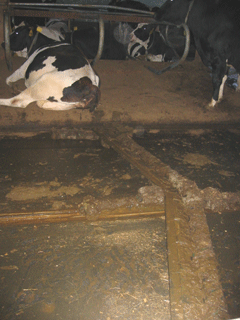
A machine scrapes the poop out from under the cows and it is piped to the digester for processing. (Photo: Ashley Ahearn)
GELLERMAN: Livestock on U.S. farms produce enough manure every year to fill a convoy of trucks stretching from San Francisco to Washington, D.C. Sure it smells, but there are bigger problems: water pollution and all the methane gas this waste releases. Methane from farms is a major contributor to global warming. But a growing number of farmers are helping to solve the problem and in the process, they’re turning their animals’ manure into money.
Living on Earth’s Ashley Ahearn reports.
[LOUD COW MOOING]
AHEARN: At five o’clock on a cold Vermont morning, even the cows don’t seem too happy to be awake.
[LOUD COW MOOING]
AHEARN: Blue Spruce Dairy Farm in Bridport, Vermont, is home to 2,000 of these vocal ladies. They’re huddled together in long pens, mooing, munching hay.
[COW PEEING CLOSE BY]
AHEARN: And going to the bathroom - to the tune of 35,000 gallons of pee and manure a day. Dealing with the waste of his large herd of Holsteins used to be a heavy burden for Earl Audet, who co-owns Blue Spruce farm with his two brothers, but things have changed.

A machine scrapes the poop out from under the cows and it is piped to the digester for processing. (Photo: Ashley Ahearn)
AHEARN: In 2005 Earl and his brothers installed an Anaerobic Digester to collect the manure and wastewater from his dairy barns and turn it into energy - enough energy to meet all the farms needs, and power 400 Vermont homes to boot.
Walking down the long concrete aisles of one of the barns, Audet points out where the alchemy of transforming poop to power begins.
AUDET: We’ve got these alley scrapers right here that run back and forth 24 hours a day. They’re always scraping the floor, scraping the manure up, and it dumps it in the center of the barn.
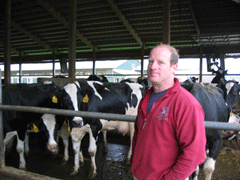
Earl Audet, co-owner of Blue Spruce Farm in Bridport, Vermont. (Photo: Ashley Ahearn)
AUDET: Yup. They just kinda step over it pretty naturally. You get some that aren’t real smart about it for a while. They’ll kinda freak out and run around.
AHEARN: From here, the manure and wastewater is pumped up the hill to another noisier building, a barn-turned-power-plant.
[LOUD DIGESTER MACHINE NOISE]
AUDET: So this over here is your digester itself. A concrete box, with a concrete cover. You’re standing on top of 12 feet of manure and the top two feet is where the gases rise and you capture the gases off from the top.
AHEARN: Inside this big concrete box, bacteria is eating cow manure and wastewater, and giving off methane gas, which is then burned on site in a generator to make electricity. Blue Spruce Farm used to pay 8,000 dollars a month for electricity, but that bill has disappeared. Now the power company is paying them 2,000 dollars a month for the extra power they feed back into the grid.
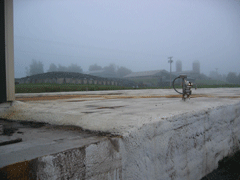
The concrete digester holds 21 days worth of manure and collects the methane gas that accumulates as manure decomposes inside. (Photo: Ashley Ahearn)
AUDET: This here is the separated manure, that’s cow manure that’s been through the digester.
AHEARN: The other byproduct of the bacteria is a fine, feathery brown substance that can be used as bedding for the cows instead of traditional wood shavings.
AUDET: It’s a lighter fluffier product and it doesn’t have those wood chips that can act like slivers. I mean, if we were laying on slivers we wouldn’t like it.
AHEARN: It’s 7,500 dollars per month in bedding Earl Audet doesn’t have to buy anymore. The digester is making it possible to look beyond the next milk check.
But for Audet it’s not just about the money. Authorities have been cracking down on manure run off.
AUDET: Oh yeah. it’s all about the environmental part of it all. To begin with it’s the land management, the nutrient management, that is making it something that we have to look into as a large farm, to keep Lake Champlain cleaner, to keep the waterways cleaner.
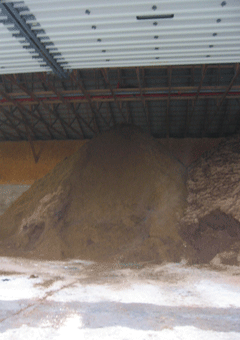
After remaining moisture is squeezed out, processed manure is re-used as bedding, saving Blue Spruce farm thousands of dollars each month. (Photo: Ashley Ahearn)
AHEARN: When nitrogen and phosphorous-rich manure is left in ponds or spread over fields, rain carries the nutrients to nearby water bodies, like Lake Champlain, creating dead zones where there’s not enough oxygen for marine life to survive.
There are now more than 140 dead zones worldwide, most of them the result of agricultural runoff.
That’s all in addition to livestock air emissions of ammonia and methane. Each year, manure from U.S. livestock is responsible for about two million metric tons of methane.
ROOS: And that’s about 7% of the total anthropogenic methane emissions from the United States.
AHEARN: Kurt Roos is head of the U.S. Environmental Protection Agency’s Agstar program, which encourages sustainable practices with grants to green-thinking farmers, including Earl Audet. Roos says that as the industry grows, digesters are taking a bite out of the methane emissions from livestock waste.
ROOS: I’ve been doing this a long time and we’ve seen enormous growth. When I first started this there were only like, ten systems running. It’s reduced about 70,000 metric tons already.
AHEARN: The number of anaerobic digesters has more than doubled in the last two years. Around the country, about 120 digesters produce enough electricity for 25 thousand homes.
Harnessing cow methane is a growing industry with a lot of potential, and it’s attracting a new kind of business, call them methane middlemen, cow poop capitalists: people who don’t farm – instead they buy up the rights to farmer’s manure and sell the energy.
MORALES: We will do all the engineering work, you know, scout out the location, we’ll have all the documentation in place and negotiate to sell the energy, whether that’s with the local gas or electric utility or some other end user.
AHEARN: Albert Morales is the Executive Vice President of The Environmental Power Corporation, a 60 million dollar, publicly traded company.
MORALES: Right now we’re focusing on larger scale facilities. In Texas we are developing a large-scale facility that will process the manure from about 10,000 cows.
MIDKIFF: I would question whether that’s even a farm or not.
AHEARN: Ken Midkiff is the Sierra Club Conservation Chair for Missouri.
MIDKIFF: My guess is that the animals, the cows in this case, Holsteins probably, are kept on concrete where the manure and the feces and the urine are easily collected. Chances are those are going into an anaerobic. Is that a farm? I mean, you know, Sounds like a factory to me. It sounds like an industrial process.
AHEARN: The Sierra Club opposes anything that might encourage what some call factory farms, even though the digesters lower methane emissions, and dead zone causing run-off.
A recent study by the EPA says 7,000 more farms in the U.S. could install digesters. And if they did it would reduce methane emissions by 60 percent and supply power for 630,000 more homes. Not the solution to the whole energy picture perhaps, but a big part of the cow pie.
For Living on Earth, I’m Ashley Ahearn in Bridport, Vermont.
Related links:
- U.S. EPA’s Agstar, Agriculture Renewable Energy program
- Environmental Power
- Anaerobic Digester Report by the National Renewable Energies Lab
- Central VT Public Supply’s Green Power Initiative
- Sierra Club’s Statement on Anaerobic Digesters
Winged Rats or Wronged Warriors?
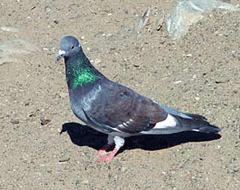
(Courtesy of National Parks Service)
GELLERMAN: Here’s the poop on pigeons: some people consider them dirty, disease-carrying pests, a real public nuisance. And then there are those people with a passion for pigeons - a person like Andrew Blechman, for example. He’s written a book about the bird titled “Pigeons: The Fascinating Saga of the World’s Most Revered and Reviled Bird” and he joins me. Thank you very much, Andrew.
BLECHMAN: Good to be here.
GELLERMAN: It really is a fascinating saga. Who would have thought that the pigeon had such an amazing history?
BLECHMAN: Well, certainly not me. I’ve tripped into this by accident and the more I learned about this bird the more I was amazed.
GELLERMAN: Well you could say it was a real accident.
BLECHMAN: Yeah, it was actually. I was at the bodega - I used to live in Manhattan - I was getting a tuna sandwich. This place made it just the way I liked it, and while I was there I met a guy named Jose and he tells me that he races pigeons and he got my attention. I didn’t know that people did that, let alone still did that. And he told me that his pigeons were thoroughbreds. That really caught my attention.
GELLERMAN: I know, like horses. They breed pigeons like they do race horses.
BLECHMAN: Absolutely, actually, in fact the very best pigeons they can bring in a pot of a million dollars at an international race. Actually they’re sold at auction for tens of thousands of dollars. And they’re studded out for several thousand dollars a go.
GELLERMAN: They’re related to doves.
BLECHMAN: Yeah, actually they are. They’re called the rock dove. In fact pigeon is just basically French for “dove.” Just like “paloma” is Spanish for pigeon or dove.
GELLERMAN: Do all pigeons home?
BLECHMAN: Yes, all rock doves do. Some do it better than others through practice, such as the homing pigeons, I mean they are thoroughbreds but they all do home. They used to be cliff dwellers. And let’s say that they were, think of the Cliffs of Dover. They would basically nest in the cliffs and then they would forage inland for food. And they would never abandon the nest. And when they mate they mate for life so they would always come back with their food. They basically honed that skill to find their way back.
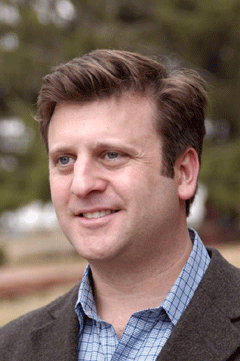
Andrew Blechman is author of "Pigeons: The Fascinating Saga of the World's Most Revered and Reviled Bird" (Photo: Holy Rockwell)
BLECHMAN: You know it’s funny you should ask. I talked to the very top people in the field including a gentleman at Cornell who dedicated his life to this and no one’s entirely sure. But there are a lot of theories out there and they do have an idea how it does. But they actually are able to sense a magnetic field around the earth. They’re also able to know where they are using the sun, and the moon, and the stars basically. And the other thing is they have ultrasound hearing so they can gauge where they are. They can hear wind over the Rockies from 2,000 miles away, and gauge where they are by that as well.
GELLERMAN: Well they have extraordinary endurance and speed.
BLECHMAN: Yeah, they routinely will fly 600-mile races at more than 60 miles an hour.
GELLERMAN: You write about pigeons playing a role, an important role, in the Battle of Waterloo.
BLECHMAN: Actually, they play, I would almost say, a financial role. Baron Rothschild at the time he sent a currier with a pigeon to the battle so that the minute that Napoleon lost, the message was then flown to England by pigeon where he got the news a day early and of course he invested accordingly. At the time don’t forget, pigeons were the fastest way to get anything anywhere. They were basically FedEx or Airborne Express. Other than a pigeon all you had was a horse going at about a trot or a gallop.
GELLERMAN: They have an illustrious history. I didn’t realize there were more pigeons honored as heroes in World War One and Two than canines.
BLECHMAN: Yeah, when you look at a pigeon in the park you wouldn’t think that guy’s related to war heroes but they are. In fact, they’re decorated metal war heroes. One million pigeons served in World War One and Two and literally saved thousands of soldier’s lives.

(Courtesy of National Parks Service)
BLECHMAN: Yeah, they would ferry critical messages from one place back to headquarters. And they invariably made it back, and quickly. Now think about this too: the first Olympics in 776 BC, the news of the results of the winners was actually sent out to all of the villages by pigeons.
GELLERMAN: Charles Darwin, you write, didn’t get his inspiration for the theory of natural selection from finches, but from pigeons.
BLECHMAN: You know, it’s interesting. We always talk about the finches when we think of Darwin, but that was very early on. That’s when he first got some inklings of what was going on. But it was actually pigeons that he used. He was a pigeon fancier and he would breed them in his backyard.
GELLERMAN: So, you have so many people that love pigeons, but they get such a bad rap. You could say they were, and I’m going to make a bad joke, pigeon-holed.
BLECHMAN: Yeah, they are pigeonholed. And it’s a critical issue. This is an absolutely horribly persecuted bird. The put caustic gels on perches, which burn through its feet. It’s poisoned routinely, electrocuted. And it’s actually a phenomenal animal.
GELLERMAN: Well, Tom Lehrer once wrote about poisoning pigeons in the park with cyanide-coated peanuts.
BLECHMAN: Yeah, somewhere it became funny to persecute pigeons. I’m not really sure where that came. I was always told that to pick on someone smaller than you just wasn’t particularly cool.
GELLERMAN: Well, could it be Woody Allen in Stardust Memories, he called them what, rats...
BLECHMAN: Rats with wings, yeah. It’s believed he invented the phrase “rats with wings.” But they’re really not. In fact, they’re no dirtier than we are. They live off what we drop.
GELLERMAN: Well, what about what they drop? Isn’t that like, really bad for us?
BLECHMAN: No, it’s really no different than what we drop. The problem is that they don’t have toilets. And the problem really is that there’s too many of them. If we had fewer pigeons it wouldn’t be a bigger problem. But then again, you know, wildlife can be inconvenient.
GELLERMAN: Especially urban wildlife. They’re one of the last real vestiges of urban wildlife.
BLECHMAN: And that’s why we really need to appreciate them. I found, that when I lived in New York City, that they really animate the place.
GELLERMAN: So, Andrew, what is your suggestion? What do we do with pigeons to solve the problem?
BLECHMAN: You know humane pigeon control really isn’t that difficult. It’s very simple, really, and they do it all through Germany, Switzerland, and the BENOLUX countries, you know the Netherlands and Holland. And what you do is you create pigeon coops. They’re really just hen houses. And you put them in public areas. And they can be quite beautiful; you can have contests for designing them. And you ask people to feed the birds there and that’s were they will breed. And at the end of each week you just cultivate the eggs, you just remove the eggs. And you can reduce the pigeon population by half in a matter of a year or two. You know it’s interesting, for 10,000 years pigeons were considered our very best friends. And just in about the last 50 years they’ve been utterly vilified as vermin by the pest control industry. And it’s a very recent, recent thing. I’m just really hoping that people will take another look at this bird because it is just everywhere we are. Everyone can relate to pigeons.
GELLERMAN: Well, Andrew you sound like a real “philoperisteron”. Is that the word?
BLECHMAN: Well…(laughs) That is the word for it. That would be an admirer of pigeons. And I’d have to say yeah, I have become an admirer of pigeons. I can’t look at a pigeon the same way again and I don’t think after reading the book anyone else can as well. I’ve really come to admire these birds.
GELLERMAN: Well, Andrew thank you very much.
BLECHMAN: Thank you for having me.
GELLERMAN: Andrew Blechman is author of “Pigeons: the Fascinating Saga of the World’s Most Revered and Reviled Bird”.
Related links:
- Author Andrew Blechman’s website
- Pigeon Control Advisory Service International
- American Racing Pigeon Union
[MUSIC: David Ross MacDonald “`Til I’m Gone” from ‘Knuckled Brass and Bone’ (Pepper Tree Records – 2006)]
GELLERMAN: The invisible hand of the marketplace – and a new iron fisted moratorium - help save the Amazon rain forest.
ALLEN: Knowing that deforestation of the Amazon is not only devastating to biodiversity but it also is devastating to climate change, McDonalds has European customers who refuse to buy Amazon soy.
I’m Bruce Gellerman - Environmentalists and corporations think outside the bun - next time on Living on Earth from PRI.
GELLERMAN: We leave you this week, home, home on the range...
[Earth Ear: “Prairie Winds” recorded by Bernie Krause & Lang Elliott for ‘Wild Sanctuary’ (Four Winds Trading Company – 2002)]
[PRAIRIE SOUNDSCAPE WITH BISON & COYOTE CALLS]
GELLERMAN: Where seldom is heard a discouraging word of the bison and coyotes. They make their playground where the skies are not cloudy on the vast, windswept grasses of the American and Canadian plains. Lang Elliott and Bernie Krause recorded these prairie home companions for the wild sanctuary dot com audio series.
GELLERMAN: Living on Earth is produced by the World Media Foundation. Our crew includes Ashley Ahearn, Bobby Bascomb, Eileen Bolinsky, Ingrid Lobet, Helen Palmer, Mitra Taj and Jeff Young, with help from Sarah Calkins and Marilyn Govoni.
Our interns are Luke Borders, Kim Gittleson and Jessica Ilyse Smith. Jeff Turton is our technical director. Alison Lirish Dean composed our themes. You can find us at LOE dot org. Steve Curwood is our executive producer. I’m Bruce Gellerman. Thanks for listening.
ANNOUNCER: Funding for Living on Earth comes from the National Science Foundation, supporting coverage of emerging science, and Stonyfield Farm: organic yogurt and smoothies. Stonyfield pays its farmers not to use artificial growth hormones on their cows. Details at stonyfield.com. Support also comes from you our listeners, the Ford Foundation, the Town Creek Foundation, the Oak Foundation—supporting coverage of climate change and marine issues, the Bill and Melinda Gates Foundation—dedicated to the idea that all people deserve the chance to live a healthy, productive life. Information at Gates Foundation dot org. And Pax World Mutual Funds: socially and environmentally sustainable investing. Pax World: for tomorrow. On the web at paxworld dot com.
ANNOUNCER 2: PRI: Public Radio International.
Living on Earth wants to hear from you!
Living on Earth
62 Calef Highway, Suite 212
Lee, NH 03861
Telephone: 617-287-4121
E-mail: comments@loe.org
Newsletter [Click here]
Donate to Living on Earth!
Living on Earth is an independent media program and relies entirely on contributions from listeners and institutions supporting public service. Please donate now to preserve an independent environmental voice.
NewsletterLiving on Earth offers a weekly delivery of the show's rundown to your mailbox. Sign up for our newsletter today!
 Sailors For The Sea: Be the change you want to sea.
Sailors For The Sea: Be the change you want to sea.
 The Grantham Foundation for the Protection of the Environment: Committed to protecting and improving the health of the global environment.
The Grantham Foundation for the Protection of the Environment: Committed to protecting and improving the health of the global environment.
 Contribute to Living on Earth and receive, as our gift to you, an archival print of one of Mark Seth Lender's extraordinary wildlife photographs. Follow the link to see Mark's current collection of photographs.
Contribute to Living on Earth and receive, as our gift to you, an archival print of one of Mark Seth Lender's extraordinary wildlife photographs. Follow the link to see Mark's current collection of photographs.
 Buy a signed copy of Mark Seth Lender's book Smeagull the Seagull & support Living on Earth
Buy a signed copy of Mark Seth Lender's book Smeagull the Seagull & support Living on Earth

